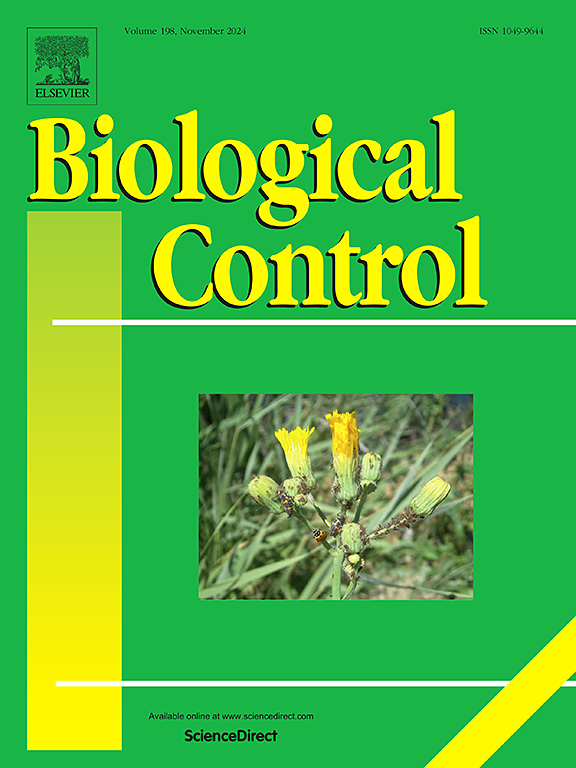管理草莓中的蓟马:无杀虫剂的选择有多有效?一个荟萃分析
IF 3.4
2区 农林科学
Q2 BIOTECHNOLOGY & APPLIED MICROBIOLOGY
引用次数: 0
摘要
蓟马是草莓作物的主要害虫,由于气温升高、某些杀虫剂的禁用和杀虫剂耐药性的增长,控制蓟马变得复杂。由于缺乏全球综合,我们的目标是:列出在草莓上测试的干预措施;比较它们的有效性;并确定有希望的新战略和研究差距。我们在2024年10月18日使用Web of Science进行了系统的文献综述。我们纳入了监测蓟马种群数量或管理干预对草莓危害的研究。59篇论文符合我们的标准,其中36篇包含阴性对照,并被纳入meta分析。西富兰克林蓟马(Frankliniella occidentalis, n = 30)和背思蓟马(Scirtothrips dorsalis, n = 10)是研究最多的物种。生物防治剂和杀虫剂是最常见的干预措施,分别在39%和47%的研究中进行了评估。捕食者是最有希望的杀虫剂替代品,并观察了19种此类物种的效果。研究最多的是黄瓜新小绥螨、留叶螟螨和蒙多瑞绥螨。在研究中,捕食者减少了51%到78%的蓟马种群,而使用杀虫剂减少了56%到79%。研究地点之间的差异比处理之间的差异更显著,这突出了气候等其他因素的重要性,而这些因素在本分析中并未考虑到该方法的有效性。使用耐受性品种和大规模诱捕分别使蓟马种群平均减少65%和68%。然而,还需要进一步的研究。最近的研究也强调了早季种群动态和周围植物群对蓟马管理的重要性。尽管取得了进展,但需要更多的研究来优化这些策略。本文章由计算机程序翻译,如有差异,请以英文原文为准。
Managing thrips in strawberries: How effective are insecticide-free options? A meta-analysis
Thrips are major pests in strawberry crops, with control becoming complex due to increasing temperatures, the banning of certain pesticides and growing insecticide resistance. As a global synthesis is lacking, we aimed to: list the interventions tested on strawberries; compare their effectiveness; and identify promising new strategies and research gaps. We conducted a systematic literature review, using Web of Science on October 18, 2024. We included studies monitoring thrips population or damage in strawberries with management interventions. Fifty-nine papers met our criteria, thirty-six of which included a negative control and were included in a meta-analysis. Frankliniella occidentalis (n = 30) and Scirtothrips dorsalis (n = 10) were the most studied species. Biocontrol agents and insecticides were the most common interventions, each assessed in 39 % and 47 % of studies, respectively. Predators were the most promising alternative to insecticides and the effects of 19 such species were observed. Neoseiulus cucumeris, Orius laevigatus and Transeius montdorensis were the most extensively studied. Across studies, predators reduced thrips populations by 51 % to 78 %, compared with 56 % to 79 % using insecticides. Variability between study sites was more significant than between treatments highlighting the importance of other factors, such as climate, not considered in this analysis in the method’s effectiveness. Using tolerant varieties and mass trapping reduced thrips populations by an average of 65 % and 68 %, respectively. However further research is needed. Recent studies also highlighted the importance of early-season population dynamics and surrounding flora on thrips management. Despite progress, more research is required to optimize these strategies.
求助全文
通过发布文献求助,成功后即可免费获取论文全文。
去求助
来源期刊

Biological Control
生物-昆虫学
CiteScore
7.40
自引率
7.10%
发文量
220
审稿时长
63 days
期刊介绍:
Biological control is an environmentally sound and effective means of reducing or mitigating pests and pest effects through the use of natural enemies. The aim of Biological Control is to promote this science and technology through publication of original research articles and reviews of research and theory. The journal devotes a section to reports on biotechnologies dealing with the elucidation and use of genes or gene products for the enhancement of biological control agents.
The journal encompasses biological control of viral, microbial, nematode, insect, mite, weed, and vertebrate pests in agriculture, aquatic, forest, natural resource, stored product, and urban environments. Biological control of arthropod pests of human and domestic animals is also included. Ecological, molecular, and biotechnological approaches to the understanding of biological control are welcome.
 求助内容:
求助内容: 应助结果提醒方式:
应助结果提醒方式:


